Kristian Kuznetsov
Feature-Level Insights into Artificial Text Detection with Sparse Autoencoders
Mar 05, 2025Abstract:Artificial Text Detection (ATD) is becoming increasingly important with the rise of advanced Large Language Models (LLMs). Despite numerous efforts, no single algorithm performs consistently well across different types of unseen text or guarantees effective generalization to new LLMs. Interpretability plays a crucial role in achieving this goal. In this study, we enhance ATD interpretability by using Sparse Autoencoders (SAE) to extract features from Gemma-2-2b residual stream. We identify both interpretable and efficient features, analyzing their semantics and relevance through domain- and model-specific statistics, a steering approach, and manual or LLM-based interpretation. Our methods offer valuable insights into how texts from various models differ from human-written content. We show that modern LLMs have a distinct writing style, especially in information-dense domains, even though they can produce human-like outputs with personalized prompts.
Robust AI-Generated Text Detection by Restricted Embeddings
Oct 10, 2024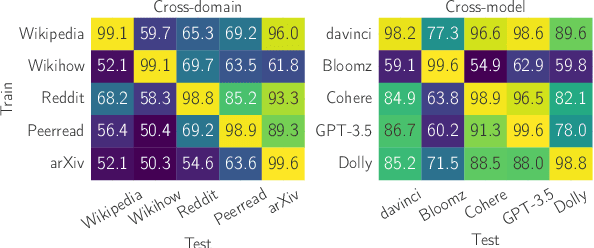
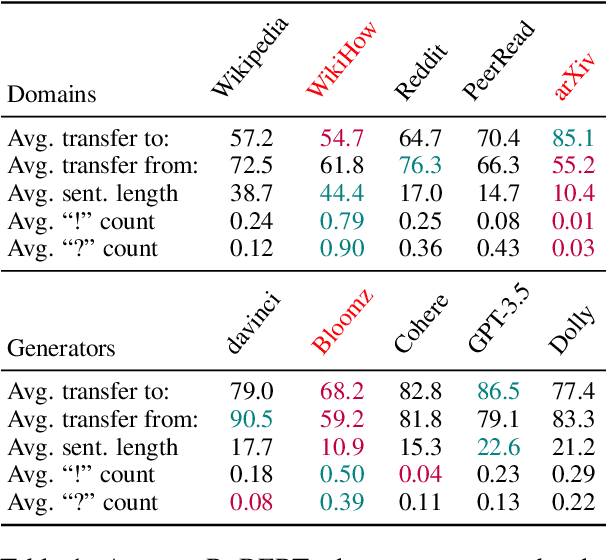
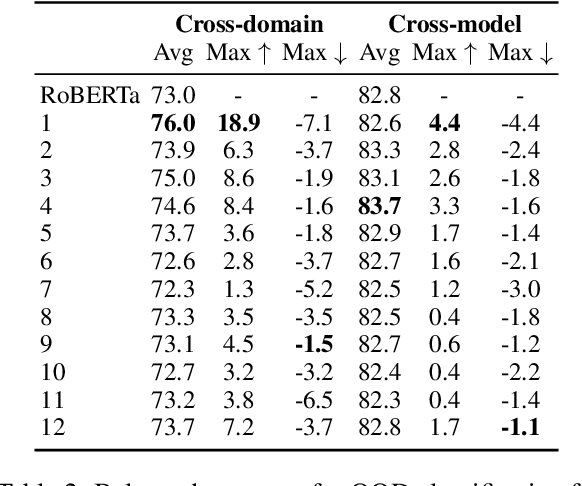
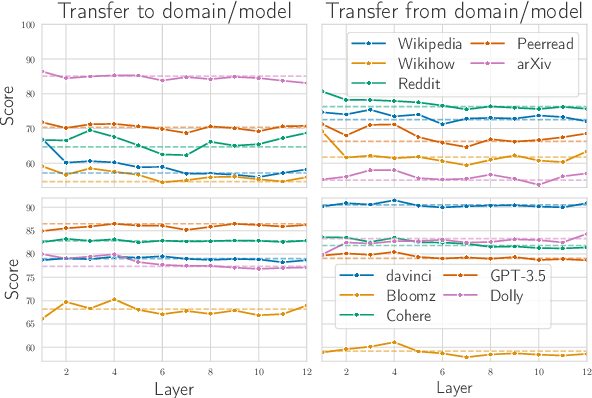
Abstract:Growing amount and quality of AI-generated texts makes detecting such content more difficult. In most real-world scenarios, the domain (style and topic) of generated data and the generator model are not known in advance. In this work, we focus on the robustness of classifier-based detectors of AI-generated text, namely their ability to transfer to unseen generators or semantic domains. We investigate the geometry of the embedding space of Transformer-based text encoders and show that clearing out harmful linear subspaces helps to train a robust classifier, ignoring domain-specific spurious features. We investigate several subspace decomposition and feature selection strategies and achieve significant improvements over state of the art methods in cross-domain and cross-generator transfer. Our best approaches for head-wise and coordinate-based subspace removal increase the mean out-of-distribution (OOD) classification score by up to 9% and 14% in particular setups for RoBERTa and BERT embeddings respectively. We release our code and data: https://github.com/SilverSolver/RobustATD
Listening to the Wise Few: Select-and-Copy Attention Heads for Multiple-Choice QA
Oct 03, 2024Abstract:A standard way to evaluate the abilities of LLM involves presenting a multiple-choice question and selecting the option with the highest logit as the model's predicted answer. However, such a format for evaluating LLMs has limitations, since even if the model knows the correct answer, it may struggle to select the corresponding letter simply due to difficulties in following this rigid format. To address this, we introduce new scores that better capture and reveal model's underlying knowledge: the Query-Key Score (QK-score), derived from the interaction between query and key representations in attention heads, and the Attention Score, based on attention weights. These scores are extracted from specific \textit{select-and-copy} heads, which show consistent performance across popular Multi-Choice Question Answering (MCQA) datasets. Based on these scores, our method improves knowledge extraction, yielding up to 16\% gain for LLaMA2-7B and up to 10\% for larger models on popular MCQA benchmarks. At the same time, the accuracy on a simple synthetic dataset, where the model explicitly knows the right answer, increases by almost 60\%, achieving nearly perfect accuracy, therefore demonstrating the method's efficiency in mitigating MCQA format limitations. To support our claims, we conduct experiments on models ranging from 7 billion to 70 billion parameters in both zero- and few-shot setups.
Artificial Text Boundary Detection with Topological Data Analysis and Sliding Window Techniques
Nov 14, 2023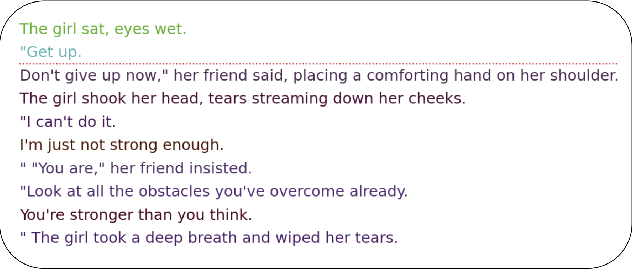
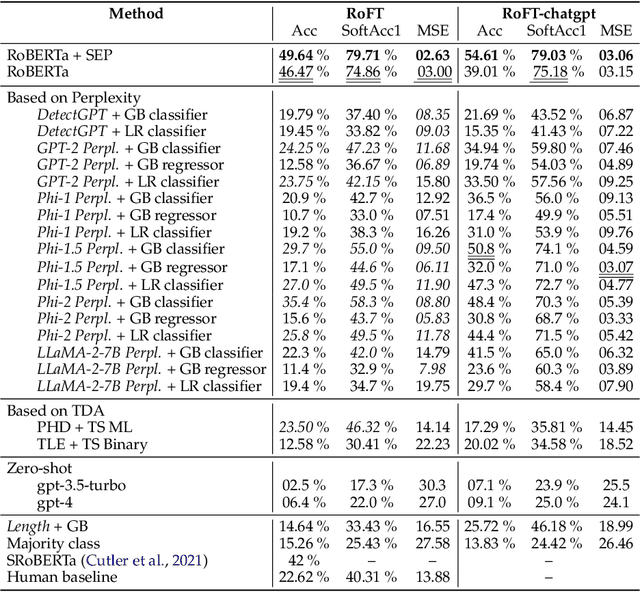
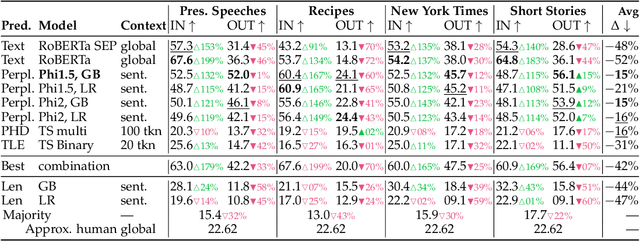
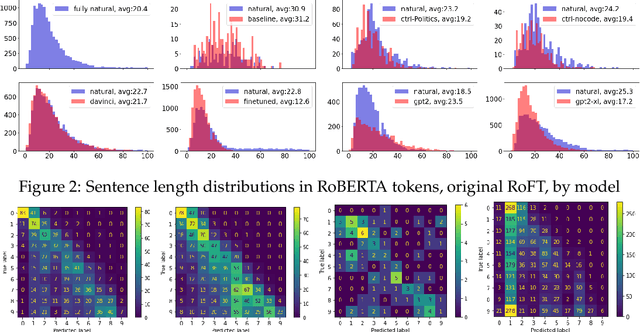
Abstract:Due to the rapid development of text generation models, people increasingly often encounter texts that may start out as written by a human but then continue as machine-generated results of large language models. Detecting the boundary between human-written and machine-generated parts of such texts is a very challenging problem that has not received much attention in literature. In this work, we consider and compare a number of different approaches for this artificial text boundary detection problem, comparing several predictors over features of different nature. We show that supervised fine-tuning of the RoBERTa model works well for this task in general but fails to generalize in important cross-domain and cross-generator settings, demonstrating a tendency to overfit to spurious properties of the data. Then, we propose novel approaches based on features extracted from a frozen language model's embeddings that are able to outperform both the human accuracy level and previously considered baselines on the Real or Fake Text benchmark. Moreover, we adapt perplexity-based approaches for the boundary detection task and analyze their behaviour. We analyze the robustness of all proposed classifiers in cross-domain and cross-model settings, discovering important properties of the data that can negatively influence the performance of artificial text boundary detection algorithms.
Portfolio Selection via Topological Data Analysis
Aug 15, 2023Abstract:Portfolio management is an essential part of investment decision-making. However, traditional methods often fail to deliver reasonable performance. This problem stems from the inability of these methods to account for the unique characteristics of multivariate time series data from stock markets. We present a two-stage method for constructing an investment portfolio of common stocks. The method involves the generation of time series representations followed by their subsequent clustering. Our approach utilizes features based on Topological Data Analysis (TDA) for the generation of representations, allowing us to elucidate the topological structure within the data. Experimental results show that our proposed system outperforms other methods. This superior performance is consistent over different time frames, suggesting the viability of TDA as a powerful tool for portfolio selection.
Intrinsic Dimension Estimation for Robust Detection of AI-Generated Texts
Jun 07, 2023



Abstract:Rapidly increasing quality of AI-generated content makes it difficult to distinguish between human and AI-generated texts, which may lead to undesirable consequences for society. Therefore, it becomes increasingly important to study the properties of human texts that are invariant over text domains and various proficiency of human writers, can be easily calculated for any language, and can robustly separate natural and AI-generated texts regardless of the generation model and sampling method. In this work, we propose such an invariant of human texts, namely the intrinsic dimensionality of the manifold underlying the set of embeddings of a given text sample. We show that the average intrinsic dimensionality of fluent texts in natural language is hovering around the value $9$ for several alphabet-based languages and around $7$ for Chinese, while the average intrinsic dimensionality of AI-generated texts for each language is $\approx 1.5$ lower, with a clear statistical separation between human-generated and AI-generated distributions. This property allows us to build a score-based artificial text detector. The proposed detector's accuracy is stable over text domains, generator models, and human writer proficiency levels, outperforming SOTA detectors in model-agnostic and cross-domain scenarios by a significant margin.
Topological Data Analysis for Speech Processing
Dec 02, 2022



Abstract:We apply topological data analysis (TDA) to speech classification problems and to the introspection of a pretrained speech model, HuBERT. To this end, we introduce a number of topological and algebraic features derived from Transformer attention maps and embeddings. We show that a simple linear classifier built on top of such features outperforms a fine-tuned classification head. In particular, we achieve an improvement of about $9\%$ accuracy and $5\%$ ERR on four common datasets; on CREMA-D, the proposed feature set reaches a new state of the art performance with accuracy $80.155$. We also show that topological features are able to reveal functional roles of speech Transformer heads; e.g., we find the heads capable to distinguish between pairs of sample sources (natural/synthetic) or voices without any downstream fine-tuning. Our results demonstrate that TDA is a promising new approach for speech analysis, especially for tasks that require structural prediction. Appendices, an introduction to TDA, and other additional materials are available here - https://topohubert.github.io/speech-topology-webpages/
 Add to Chrome
Add to Chrome Add to Firefox
Add to Firefox Add to Edge
Add to Edge